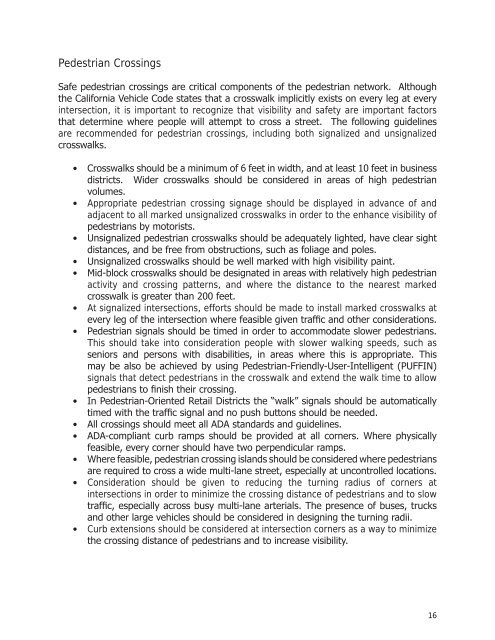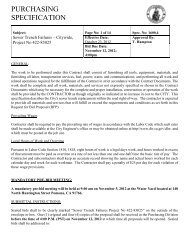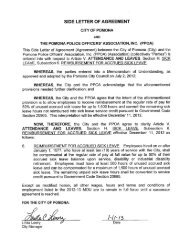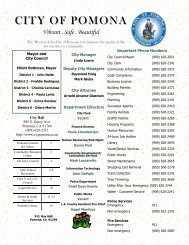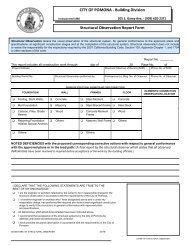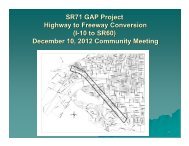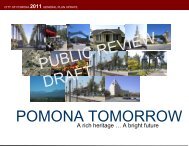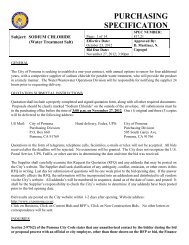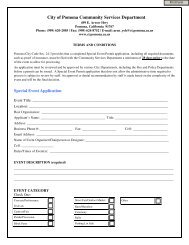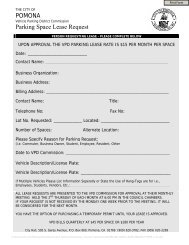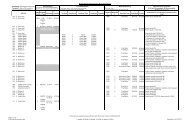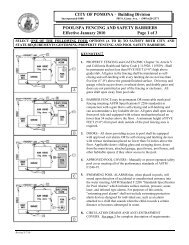Active Transportation Plan - City of Pomona
Active Transportation Plan - City of Pomona
Active Transportation Plan - City of Pomona
You also want an ePaper? Increase the reach of your titles
YUMPU automatically turns print PDFs into web optimized ePapers that Google loves.
Pedestrian Crossings<br />
Safe pedestrian crossings are critical components <strong>of</strong> the pedestrian network. Although<br />
the California Vehicle Code states that a crosswalk implicitly exists on every leg at every<br />
intersection, it is important to recognize that visibility and safety are important factors<br />
that determine where people will attempt to cross a street. The following guidelines<br />
are recommended for pedestrian crossings, including both signalized and unsignalized<br />
crosswalks.<br />
• Crosswalks should be a minimum <strong>of</strong> 6 feet in width, and at least 10 feet in business<br />
districts. Wider crosswalks should be considered in areas <strong>of</strong> high pedestrian<br />
volumes.<br />
• Appropriate pedestrian crossing signage should be displayed in advance <strong>of</strong> and<br />
adjacent to all marked unsignalized crosswalks in order to the enhance visibility <strong>of</strong><br />
pedestrians by motorists.<br />
• Unsignalized pedestrian crosswalks should be adequately lighted, have clear sight<br />
distances, and be free from obstructions, such as foliage and poles.<br />
• Unsignalized crosswalks should be well marked with high visibility paint.<br />
• Mid-block crosswalks should be designated in areas with relatively high pedestrian<br />
activity and crossing patterns, and where the distance to the nearest marked<br />
crosswalk is greater than 200 feet.<br />
• At signalized intersections, efforts should be made to install marked crosswalks at<br />
every leg <strong>of</strong> the intersection where feasible given traffic and other considerations.<br />
• Pedestrian signals should be timed in order to accommodate slower pedestrians.<br />
This should take into consideration people with slower walking speeds, such as<br />
seniors and persons with disabilities, in areas where this is appropriate. This<br />
may be also be achieved by using Pedestrian-Friendly-User-Intelligent (PUFFIN)<br />
signals that detect pedestrians in the crosswalk and extend the walk time to allow<br />
pedestrians to finish their crossing.<br />
• In Pedestrian-Oriented Retail Districts the “walk” signals should be automatically<br />
timed with the traffic signal and no push buttons should be needed.<br />
• All crossings should meet all ADA standards and guidelines.<br />
• ADA-compliant curb ramps should be provided at all corners. Where physically<br />
feasible, every corner should have two perpendicular ramps.<br />
• Where feasible, pedestrian crossing islands should be considered where pedestrians<br />
are required to cross a wide multi-lane street, especially at uncontrolled locations.<br />
• Consideration should be given to reducing the turning radius <strong>of</strong> corners at<br />
intersections in order to minimize the crossing distance <strong>of</strong> pedestrians and to slow<br />
traffic, especially across busy multi-lane arterials. The presence <strong>of</strong> buses, trucks<br />
and other large vehicles should be considered in designing the turning radii.<br />
• Curb extensions should be considered at intersection corners as a way to minimize<br />
the crossing distance <strong>of</strong> pedestrians and to increase visibility.<br />
16


